To build a solar box cooker, you'll need a sturdy base like cardboard or plywood, reflective materials such as aluminum foil or Mylar, and insulation like fiberglass or newspaper. A transparent cover of glass or plastic is essential, along with a dark-colored cooking pot for heat absorption. Don't forget an oven thermometer to monitor temperatures accurately. You'll also need aluminum foil for lining and reflecting sunlight, plus adhesives and cutting tools for assembly. Each component plays an important role in harnessing solar energy efficiently, and understanding their functions can help you create a more effective cooker.
Cardboard Box or Plywood
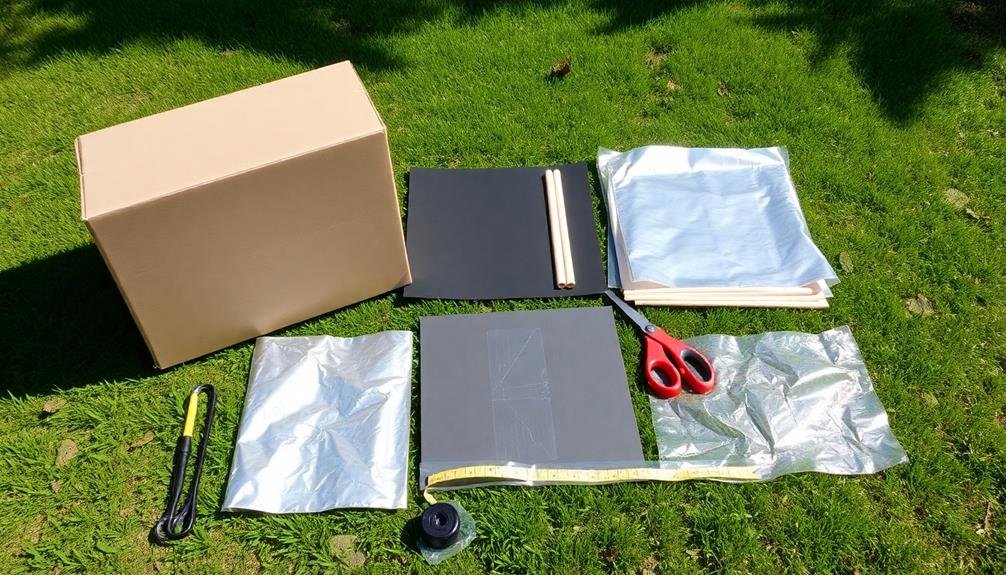
When building a solar box cooker, your first decision is whether to use a cardboard box or plywood for the main structure. Both materials have their advantages and drawbacks, so consider your specific needs and resources.
Cardboard boxes are readily available, lightweight, and easy to work with. They're ideal for temporary or portable cookers, and you can often find them for free. However, cardboard isn't as durable as plywood and may not withstand prolonged exposure to heat and moisture.
If you choose cardboard, select a sturdy box with thick walls and reinforce it with additional layers or waterproof coating.
Plywood offers greater durability and longevity. It's more resistant to weather and can support heavier pots and larger quantities of food. Plywood cookers are better suited for permanent installations or frequent use.
However, they're heavier, more expensive, and require more tools and skills to construct. When using plywood, opt for exterior-grade sheets to resist moisture and warping.
Whichever material you choose, make sure it's clean, free from chemicals, and large enough to accommodate your cooking needs.
Reflective Material
A crucial component of any solar box cooker is the reflective material. You'll need this to concentrate sunlight into the cooking area, maximizing heat absorption. The most common and effective options are aluminum foil, mylar, or reflective emergency blankets. When choosing your reflective material, consider durability, cost, and ease of application.
To apply the reflective material, you'll need to cover the interior walls and bottom of your box cooker. If you're using aluminum foil, make sure it's smoothly attached without wrinkles or air bubbles. For mylar or emergency blankets, cut them to size and secure them with adhesive or tape.
Here's a comparison of popular reflective materials:
| Material | Reflectivity | Durability | Cost |
|---|---|---|---|
| Aluminum Foil | High | Low | Low |
| Mylar | Very High | Medium | Medium |
| Emergency Blanket | High | Medium | Low |
| Reflective Tape | Medium | High | High |
When handling reflective materials, be careful not to tear or crease them. If you're using a cardboard box, consider applying a layer of white glue before attaching the reflective material for better adhesion and longevity. Remember, the more efficiently you reflect sunlight, the better your solar box cooker will perform.
Insulation
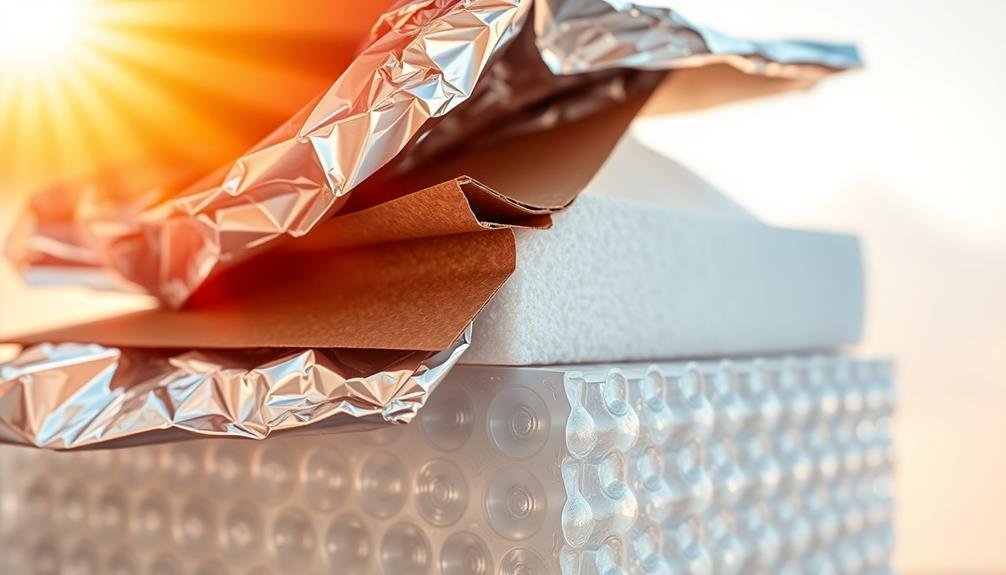
Insulation plays an essential role in maintaining the efficiency of your solar box cooker. It helps retain heat inside the cooking chamber, ensuring that the energy captured from the sun isn't lost to the surrounding environment.
You'll want to choose materials that have low thermal conductivity to maximize your cooker's performance.
Common insulation options include:
- Fiberglass: Widely available and effective, but handle with care to avoid skin irritation.
- Wool: Natural and eco-friendly, but may be more expensive.
- Styrofoam: Lightweight and affordable, but not environmentally friendly.
- Newspaper: Cheap and readily available, but less effective than other options.
When selecting insulation, consider factors like thickness, R-value, and moisture resistance. Aim for a layer at least 1-2 inches thick around the cooking chamber.
You can use multiple layers of different materials to enhance insulation properties.
Don't forget to insulate the bottom of your cooker as well. This prevents heat loss through the base and improves overall efficiency.
Secure the insulation in place with tape or adhesive, ensuring there are no gaps or air pockets that could compromise its effectiveness.
Glass or Plastic Cover
When choosing a transparent cover for your solar box cooker, you'll need to take into account various types of materials, including glass and plastic options.
The cover plays a vital role in insulation and heat retention, affecting the cooker's overall efficiency.
You'll also want to factor in the size and thickness of the cover, as these aspects can impact durability and performance.
Types of Transparent Covers
What's the most essential component for trapping heat in your solar box cooker? It's the transparent cover, which allows sunlight to enter while preventing heat from escaping.
You've got two main options: glass or plastic.
Glass covers are durable and provide excellent heat retention. They're scratch-resistant and won't degrade in sunlight. However, they're heavier and more fragile than plastic alternatives. Tempered glass is a safer choice, as it won't shatter into sharp pieces if broken.
Plastic covers, like polycarbonate or acrylic sheets, are lightweight and shatter-resistant. They're easier to work with and transport but may scratch more easily and degrade over time in direct sunlight.
When choosing your transparent cover, consider these factors:
- Durability and longevity
- Weight and portability
- Heat retention capabilities
- Cost and availability
- Ease of cleaning and maintenance
Both glass and plastic covers can be effective for your solar box cooker. Your choice will depend on your specific needs, budget, and intended use.
Insulation and Heat Retention
Along with your transparent cover, proper insulation is essential for maximizing your solar box cooker's efficiency. You'll want to focus on materials that can trap heat effectively while minimizing heat loss to the environment. Common insulation options include fiberglass, foam board, and reflective materials like aluminum foil.
When selecting insulation, consider its R-value, which measures thermal resistance. Higher R-values indicate better insulation properties. You should aim to insulate all sides of your cooker, including the bottom, to create a well-sealed cooking chamber.
Here's a comparison of popular insulation materials:
| Material | R-value per inch | Moisture Resistance | Cost | Ease of Use | Durability |
|---|---|---|---|---|---|
| Fiberglass | 2.2-2.7 | Poor | Low | Moderate | Good |
| Foam Board | 3.6-6.5 | Excellent | Moderate | Easy | Excellent |
| Reflective Foil | 3.5-6.0 | Excellent | Low | Easy | Good |
| Wool | 3.0-3.5 | Good | High | Moderate | Excellent |
| Straw | 2.5-3.0 | Poor | Low | Difficult | Poor |
Remember to seal any gaps or seams in your insulation to prevent heat escape. You can use weatherstripping or silicone caulk to create an airtight seal around your cooker's edges, ensuring maximum heat retention and cooking efficiency.
Size and Thickness Considerations
The size and thickness of your solar box cooker's transparent cover play essential roles in its overall performance. When choosing a glass or plastic cover, consider the cooker's dimensions and intended use. A larger cover allows more sunlight to enter, potentially increasing cooking efficiency, but it may also lead to greater heat loss if not properly insulated.
For ideal results, aim for a cover that's:
- Large enough to capture maximum sunlight
- Thick enough to provide insulation
- Lightweight for easy handling
- Durable to withstand outdoor conditions
- Sized proportionally to your cooker's base
Generally, a thickness of 3-4mm for glass or 0.5-1mm for plastic works well. Thicker materials offer better insulation but reduce light transmission.
If you're using plastic, opt for UV-resistant types to prevent degradation over time.
Dark-Colored Cooking Pot
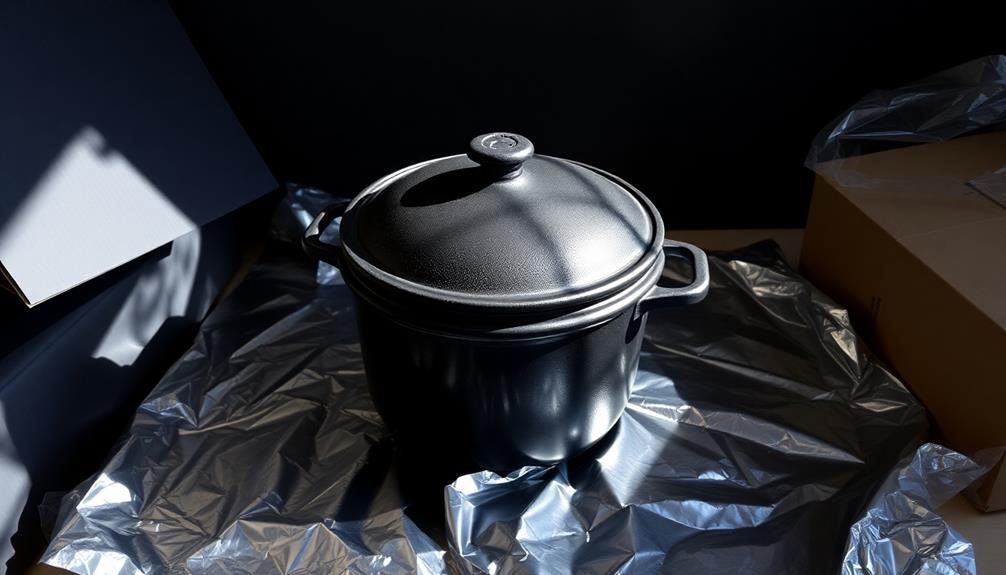
Inside your solar box cooker, a dark-colored cooking pot plays an important role. It's essential for absorbing and retaining heat efficiently, which is crucial for cooking your food. Choose a pot with a matte black exterior, as this color absorbs sunlight most effectively. Avoid shiny or reflective surfaces, as they'll reduce heat absorption.
Opt for materials with high thermal conductivity, such as cast iron, dark anodized aluminum, or enameled steel. These materials distribute heat evenly and maintain temperature well. The pot's size should match your cooking needs and fit comfortably inside the cooker. A lid is important to trap steam and heat, speeding up the cooking process.
Consider using a thin-walled pot for quicker heating, but remember that thicker walls retain heat better for longer cooking times. If you're on a budget, you can create a DIY solution by painting an existing pot with non-toxic, heat-resistant black paint. Make sure the paint is food-safe and can withstand high temperatures.
Oven Thermometer
You'll need an oven thermometer to monitor your solar box cooker's temperature accurately.
Choose a thermometer that can withstand high temperatures and has a clear, easy-to-read display.
Importance of Temperature Monitoring
One essential component for your solar box cooker is an oven thermometer.
It's important for monitoring the internal temperature of your cooker, ensuring your food reaches safe cooking temperatures, and helping you adjust cooking times accordingly.
Without proper temperature monitoring, you risk undercooking or overcooking your meals, compromising both safety and taste.
An oven thermometer allows you to:
- Verify that your cooker reaches ideal cooking temperatures
- Determine when to add or remove food from the cooker
- Adjust the cooker's position to maximize sun exposure
- Experiment with different insulation materials and their effects
- Track temperature fluctuations throughout the day
Choosing Suitable Oven Thermometer
Now that you understand the importance of temperature monitoring, selecting the right oven thermometer for your solar box cooker is key.
Look for a thermometer specifically designed for ovens, capable of withstanding high temperatures up to at least 300°F (150°C). Digital thermometers offer precise readings, but analog options can be more durable and don't require batteries.
Choose a thermometer with a large, easy-to-read display that you can see through the cooker's window without opening it. Confirm it has a wide temperature range to accommodate various cooking needs. Some thermometers come with probes, which can be helpful for monitoring food temperature directly.
Consider thermometers with alarms or timers to alert you when your desired temperature is reached. Stainless steel construction is preferable for durability and easy cleaning. Look for models with a hook or stand for convenient placement inside the cooker.
Before purchasing, check reviews to verify the thermometer's accuracy and reliability. Some popular brands include Taylor, CDN, and Rubbermaid.
Aluminum Foil
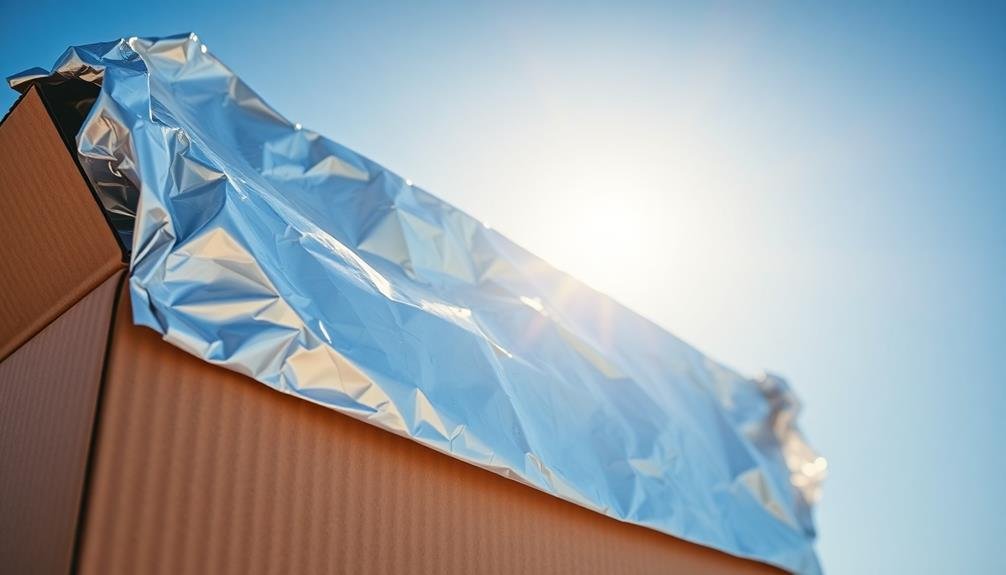
Aluminum foil plays a crucial role in constructing an effective solar box cooker. It's essential for reflecting and directing sunlight into the cooking chamber, maximizing heat retention. You'll need heavy-duty aluminum foil for durability and better performance.
When selecting foil for your solar cooker, opt for the widest roll available to minimize seams and potential heat loss.
To use aluminum foil effectively in your solar box cooker:
- Line the interior walls of the cooking chamber
- Cover the reflector panels on the lid
- Wrap the cooking pot or pan for increased heat absorption
- Create a reflective base inside the cooker
- Seal any gaps or cracks to prevent heat escape
Ensure you smooth out wrinkles and creases in the foil to maintain optimal reflective properties. When applying foil to surfaces, use a spray adhesive or non-toxic glue to secure it in place. This prevents shifting and maintains the cooker's efficiency.
Remember to handle the foil carefully to avoid tears or punctures. If you're using a cardboard box for your cooker, consider adding an extra layer of insulation beneath the foil to enhance heat retention and cooking performance.
Adhesives and Cutting Tools
Choosing the right adhesive-tool combo is vital for constructing a durable solar box cooker. You'll need a strong adhesive to bond various materials together, such as cardboard, wood, and aluminum foil. Glue sticks work well for attaching lightweight materials, while wood glue is ideal for securing wooden components. For a more robust bond, consider using silicone sealant or epoxy, especially for areas that might be exposed to heat or moisture.
As for cutting tools, you'll want a sharp utility knife or box cutter for precise cuts on cardboard and thin materials. Scissors are useful for trimming aluminum foil and other flexible materials. If you're working with wood, a handsaw or jigsaw will come in handy. Don't forget a sturdy ruler or straight edge to guide your cuts and guarantee accuracy.
Safety should be your top priority when using these tools. Always cut away from yourself and wear protective gloves when handling sharp objects. Keep your work area clean and organized to prevent accidents.
With the right adhesives and cutting tools, you'll be able to construct a sturdy and efficient solar box cooker that'll serve you well for years to come.
Frequently Asked Questions
How Long Does It Take to Cook Food in a Solar Box Cooker?
Cooking time in a solar box cooker varies depending on the food and sunlight intensity. You'll typically need 1-3 hours for most dishes. On a sunny day, you can expect faster cooking times than on cloudy days.
What Types of Food Can Be Prepared in a Solar Box Cooker?
You can prepare a wide variety of foods in a solar box cooker. You'll be able to cook meats, vegetables, grains, and even bake bread. It's perfect for soups, stews, casseroles, and slow-cooked dishes. Don't forget desserts!
Can a Solar Box Cooker Be Used in Cloudy or Cold Weather?
You can use a solar box cooker in cloudy or cold weather, but it'll be less effective. You'll need more time to cook your food, and the temperature won't get as high. It's best to use it on sunny days.
How Hot Can a Solar Box Cooker Get Inside?
You'll be surprised at how hot a solar box cooker can get! It can reach temperatures up to 300°F (150°C) on sunny days. That's hot enough to cook most foods, bake bread, and even sterilize water.
Are There Any Safety Precautions When Using a Solar Box Cooker?
Yes, you should take safety precautions. Always use oven mitts when handling hot cookware. Don't look directly at reflective surfaces. Keep children supervised. Be cautious of steam when opening the cooker. Ascertain it's stable on flat ground.
In Summary
You've now got all the essentials to build your solar box cooker. With these materials, you'll be able to harness the sun's power for eco-friendly cooking. Don't forget to experiment with different designs and placements to maximize efficiency. As you use your cooker, you'll learn to adjust cooking times and temperatures. Remember, patience is key – solar cooking takes longer than conventional methods, but it's worth the wait for sustainable, energy-free meals.
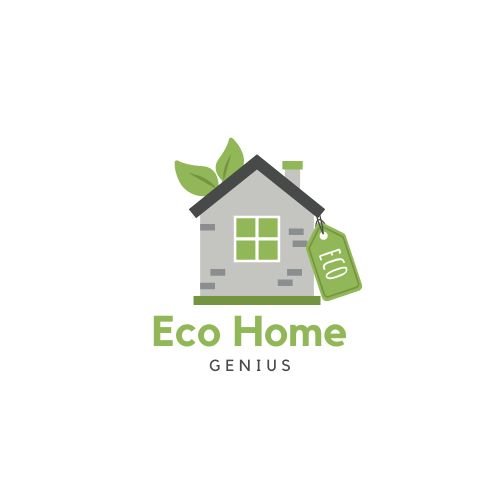

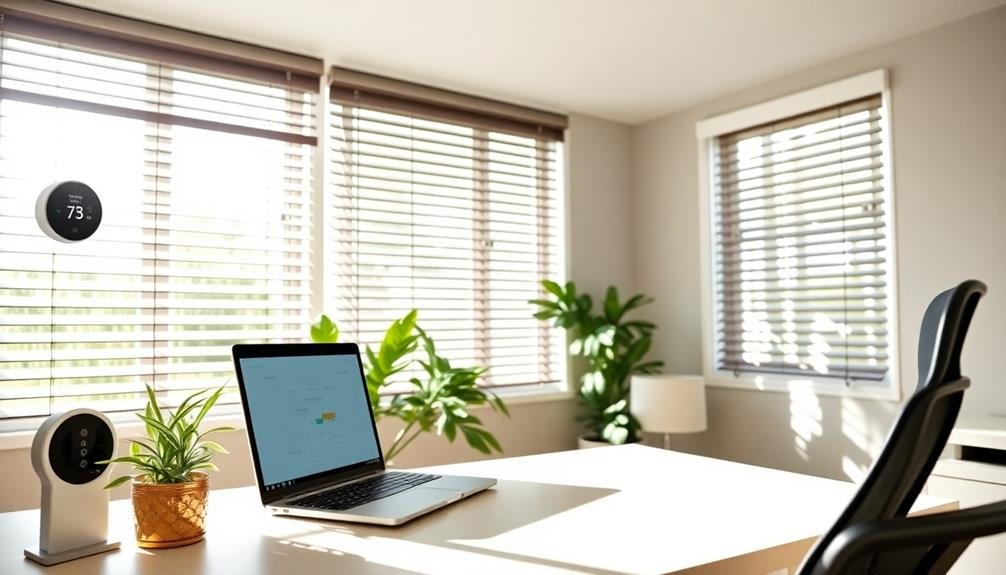
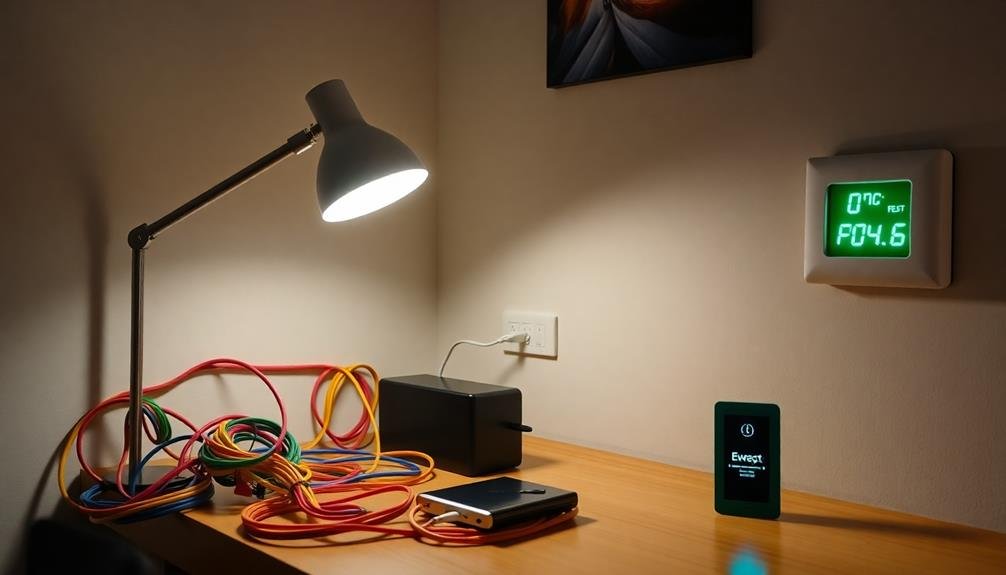
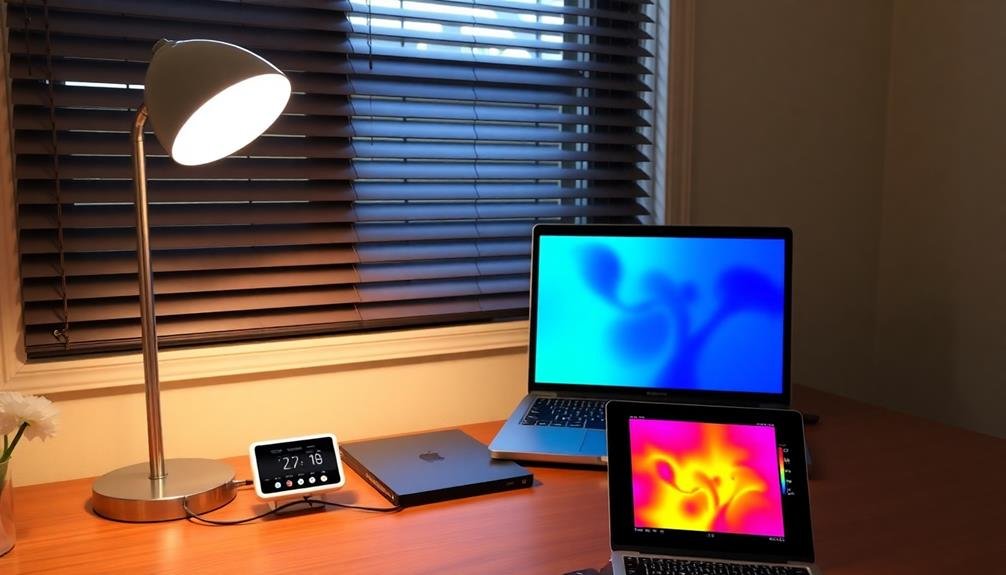
Leave a Reply